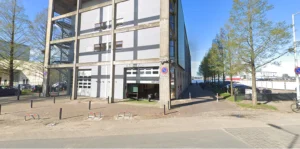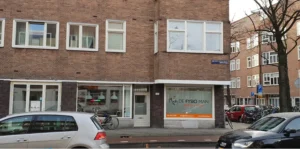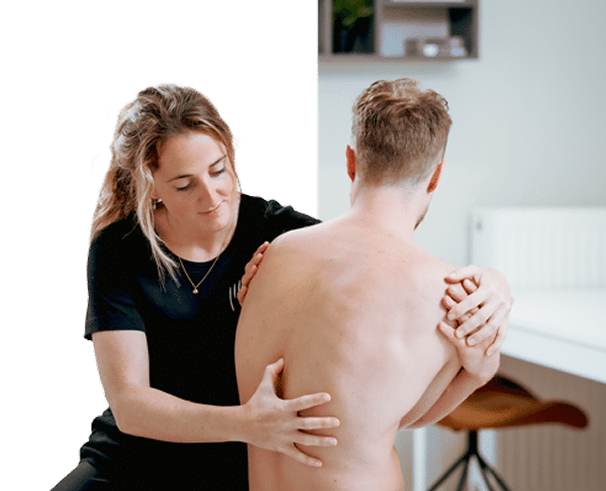What are lower back complaints
Lower back pain is discomfort in and around the lower lower back. Pain can come from muscles, ligaments, joints and intervertebral discs. You may feel pain locally in the lower back or with radiation to buttock, hip or leg. Sometimes you experience lower back and abdominal pain such as pain in lower abdomen and lower back or pain in lower back and abdomen. Tension in hips and upper back also sometimes plays a role.
Symptoms of lower back pain
- Lower back or lower back pain while sitting, bending or twisting
- Lower back pain shooting or lower back pain shooting with unexpected movement
- Searing pain lower back right or left, sometimes with radiation to leg
- Lower back pain after sleeping or lower back and hip pain after sleeping with starting stiffness
- Lower back muscle pain after strain or prolonged standing
- Pain in lower back left with radiation to leg and pain from lower back to leg
- Pain in legs and lower back when walking or standing for longer periods of time
Recognize these signs. Have your symptoms assessed. Starting early speeds recovery.
Causes of lower back pain
Lower back pain often arises from a sum of factors. Prolonged sitting without breaks, unfavorable working heights and little variation add to the stress. Rapidly building up with lifting or sports can excite the structures of the lower back. Osteoarthritis lower back and lower back stenosis are more common in older age and sometimes produce lower back pain with radiation. Wear lower back symptoms match stiff mornings and strain-related pain. Stress, restless sleep and little recovery increase sensitivity.
What you can do yourself
- Change positions every half hour and take short micro-breaks
- Move lightly throughout the day with short walking moments for blood flow
- Use heat for stiff muscles and then start with gentle movement
- Lift close to your body, distribute the load and choose technique over weight
- Examine your sleep. A neutral lying position with support can reduce lower back pain at night
- Does the pain get worse or continue to recur. Schedule an intake
Exercises for the lower back
Perform all exercises in a controlled and pain-free manner. Lower back and lower back exercises help reduce stiffness and build load capacity. The program below is suitable as a start. Stretching lower back should be done gently and without forcing.
- Pelvic tilt Lie supine with knees bent. Tilt the pelvis back slightly and relax. Ten repetitions
- Knee to chest alternately Pull one knee gently to chest, switching sides. Eight repetitions per side
- Hip hinge Stand upright, bend from the hip with long back and come back. Ten repetitions
- Rotational recline Knees bent, gently lower both knees to the left and right within comfort. Ten repetitions per side
- Bridge small Push the heels into the ground, lift the pelvis slightly and hold for three counts. Three times eight repetitions
A slight after pain that subsides within a day is acceptable. Does the pain increase the next day. Reduce the stimulus and rebuild.
Research and treatment at The Physio Man
We start with an intake and a clear analysis of your load. We look at posture, lifting and movement patterns, test hip and spine mobility and measure strength and coordination. This is how we determine what triggers your lower back pain and what adjustments provide immediate relief.
A treatment program usually consists of
- Targeted exercise therapy for mobility, strength and coordination of trunk and hip
- Coaching on work attitude, breaks and daily exercise times
- Mobilizations and tissue techniques when appropriate to your complaint
- Build-up schedule with clear pain boundaries and measurable steps
- Advice on assistive devices. A lower back brace or lower back brace can provide temporary support but does not replace training
Our goal is for you to move freely and pain-free again with confidence in your body.
When immediate help is needed
- Severe new pain with failure, numbness or loss of strength in one or both legs
- Problems urinating or defecating combined with lower back pain
- Fever, feeling sick or unexplained weight loss along with back pain
- Severe trauma with persistent pain or visible deformity
In these situations, contact your doctor or urgent care immediately.
Frequently Asked Questions
Why do I have lower back pain after sleeping
Stiffness often plays a role due to limited movement at night. A neutral lying position and a short morning routine with gentle mobility reduces lower back pain after sleep and lower back and hip pain after sleep.
What does a shooting pain lower back mean
A sudden twitching of muscles or joints. Usually harmless and easily managed with relaxation, warmth and gentle movement. Does pain shooting in lower back keep returning. Have it evaluated.
Do lower back exercises help with nagging pain
Yes, if built up slowly. Start with mobility and low-intensity strength. Add stability and lifting training later. Exercises reduce lower back muscle soreness and improve load capacity.
What if pain migrates from lower back to leg
This fits with nerve irritation. Often this improves with a targeted exercise and exercise plan. If there is persistent loss of strength or increasing loss of sensation, contact your doctor.
Is pain in lower lower back the same as wear and tear
Not always. Wear and tear lower back symptoms come with age and are often not the main reason for pain. We focus on what your back can do and how to build up safely.
Your next step
Don’t stick around with lower back pain. With targeted treatment and personal guidance, you work on recovery and stability. Together we tackle the cause and you build safely towards your goals.
Make an appointment at The Physio Man now and work with us to achieve a strong and pain-free lower back.
Share this article:


